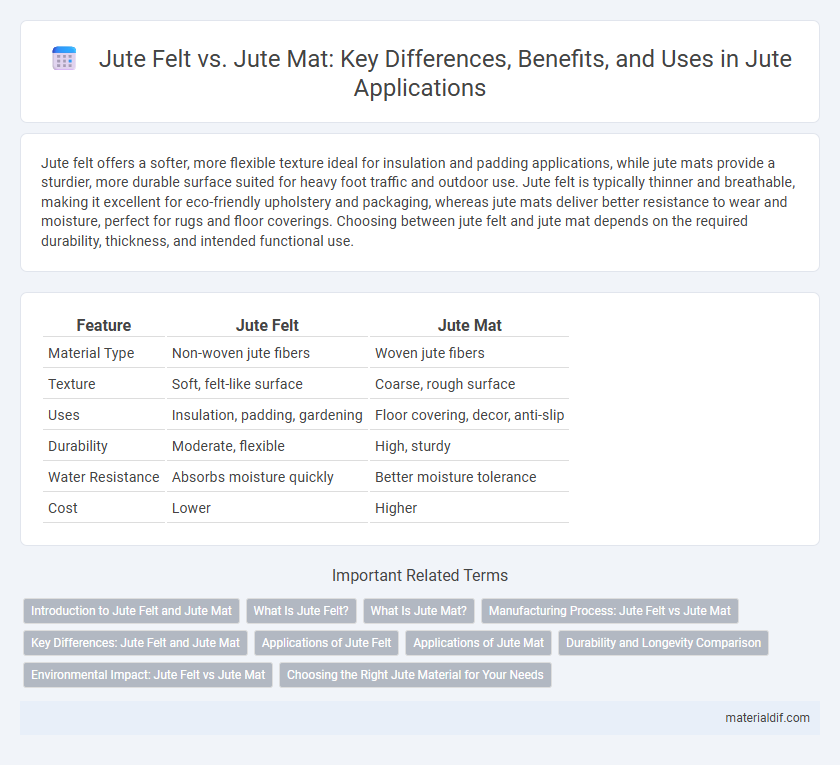Jute felt offers a softer, more flexible texture ideal for insulation and padding applications, while jute mats provide a sturdier, more durable surface suited for heavy foot traffic and outdoor use. Jute felt is typically thinner and breathable, making it excellent for eco-friendly upholstery and packaging, whereas jute mats deliver better resistance to wear and moisture, perfect for rugs and floor coverings. Choosing between jute felt and jute mat depends on the required durability, thickness, and intended functional use.
Table of Comparison
| Feature | Jute Felt | Jute Mat |
|---|---|---|
| Material Type | Non-woven jute fibers | Woven jute fibers |
| Texture | Soft, felt-like surface | Coarse, rough surface |
| Uses | Insulation, padding, gardening | Floor covering, decor, anti-slip |
| Durability | Moderate, flexible | High, sturdy |
| Water Resistance | Absorbs moisture quickly | Better moisture tolerance |
| Cost | Lower | Higher |
Introduction to Jute Felt and Jute Mat
Jute felt is a non-woven fabric made from loose jute fibers bonded together, offering cushioning, insulation, and erosion control benefits. Jute mats are woven products created by interlacing jute yarns tightly, providing durability and strength for applications like flooring, packaging, and geotextiles. Both jute felt and jute mats are sustainable, biodegradable materials widely utilized in eco-friendly construction and agriculture.
What Is Jute Felt?
Jute felt is a non-woven textile made from natural jute fibers densely compressed together to create a soft, thick, and durable material primarily used for insulation, packaging, and cushioning. Unlike jute mats, which are woven and typically coarser, jute felt offers better flexibility and cushioning properties due to its felted structure. This natural fiber product is biodegradable, eco-friendly, and highly valued in sustainable construction and agricultural applications.
What Is Jute Mat?
Jute mat is a woven or non-woven fabric made from natural jute fibers, designed primarily for floor covering and insulation purposes. It offers excellent durability, breathability, and biodegradability, making it ideal for eco-friendly home decor and agricultural uses. Unlike jute felt, which is a compressed non-woven material used for padding or cushioning, jute mat provides a sturdier texture suited for heavy-duty applications.
Manufacturing Process: Jute Felt vs Jute Mat
Jute felt is manufactured by mechanically entangling jute fibers through needle-punching or hot calendaring, resulting in a dense, non-woven fabric ideal for insulation and cushioning applications. In contrast, jute mats are produced by weaving or stitching jute yarns into structured, grid-like patterns, providing durability and strength for floor coverings and erosion control. The manufacturing process differences influence the texture, thickness, and functional properties of jute felt and jute mats.
Key Differences: Jute Felt and Jute Mat
Jute felt is a soft, non-woven fabric made from loosely bonded jute fibers, primarily used for cushioning, insulation, and as a backing material in upholstery. Jute mats are tightly woven, durable products designed for floor coverings, erosion control, and gardening applications where strength and wear resistance are essential. The key difference lies in their structure and application: jute felt offers flexibility and softness for padding, while jute mats provide robust, stable surfaces for high-traffic or environmental protection uses.
Applications of Jute Felt
Jute felt is widely used in agricultural and horticultural applications due to its excellent moisture retention and soil protection properties, making it ideal for seed germination and plant root insulation. It also serves as an eco-friendly erosion control material on slopes and embankments, promoting vegetation growth while preventing soil displacement. Compared to jute mats, jute felt is softer, more flexible, and better suited for cushioning and insulation in packaging and upholstery.
Applications of Jute Mat
Jute mats are widely used in agriculture for soil erosion control and seed protection due to their durable, breathable structure that supports moisture retention and root growth. Unlike jute felt, which is softer and often used in upholstery or insulation, jute mats provide a robust, environmentally friendly alternative for landscaping, pathways, and outdoor flooring. The natural biodegradability of jute mats makes them ideal for sustainable applications where long-term ground coverage is required without harming the ecosystem.
Durability and Longevity Comparison
Jute felt, made from densely compressed jute fibers, offers superior durability and resistance to wear compared to jute mats, which are typically woven and less dense. The structural composition of jute felt enhances its longevity in high-traffic or heavy-use applications by minimizing fiber breakage and deformation. In contrast, jute mats may degrade faster under similar conditions due to their looser weave and lower fiber density.
Environmental Impact: Jute Felt vs Jute Mat
Jute felt offers superior biodegradability compared to jute mat, breaking down faster and reducing landfill waste. Jute mat, while durable and effective for erosion control, tends to retain synthetic additives that slow decomposition. Choosing jute felt minimizes long-term environmental impact through natural fiber composition and lower chemical treatments.
Choosing the Right Jute Material for Your Needs
Jute felt offers a dense, insulated texture ideal for soundproofing and cushioning applications, while jute mats provide a durable, coarse surface perfect for floor coverings and erosion control. Selecting the right jute material depends on whether your priority is comfort and insulation, favoring jute felt, or toughness and surface grip, which makes jute mats more suitable. Consider the intended use environment and performance requirements such as moisture resistance, thickness, and tensile strength to ensure optimal functionality.
Jute Felt vs Jute Mat Infographic

 materialdif.com
materialdif.com